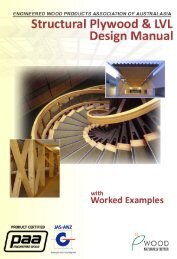Facts About Particleboard and MDF - Engineered Wood Products ...
Facts About Particleboard and MDF - Engineered Wood Products ...
Facts About Particleboard and MDF - Engineered Wood Products ...
You also want an ePaper? Increase the reach of your titles
YUMPU automatically turns print PDFs into web optimized ePapers that Google loves.
Adhesives for Jointing<br />
Although most of the adhesives commonly used for jointing natural timber are equally suitable for jointing<br />
wood panels, those made from synthetic resins are normally preferred. Animal glues are not generally<br />
suitable as their relatively high water content may cause local swelling of the board.<br />
There are many types <strong>and</strong> grades of synthetic resin adhesives available for a wide variety of specific<br />
applications. The requirements of the user together with the facilities available to him will have influence on<br />
the choice of adhesive most suitable for his purpose. The following notes therefore give general guidance on<br />
the type of adhesive suitable for particular applications.<br />
Synthetic resin adhesives consist of a syrup <strong>and</strong> a catalyst. The catalyst, which may be in either powder or<br />
liquid form, is either mixed in certain proportions or applied separately to one face <strong>and</strong> the syrup to the<br />
other. Adhesives of the mixed application variety, have the catalyst already incorporated. It is essential that<br />
the adhesive manufacturer's instructions are closely followed in all cases.<br />
For board to board joints, a urea-formaldehyde (UF) adhesive should be applied to both edges. A mixed<br />
application type is recommended. Alternatively, a polyvinyl acetate (PVA) adhesive can be used <strong>and</strong> should<br />
be of high viscosity to avoid starved glue joints.<br />
For edge lipping or veneering with wood, UF adhesives are usually best although a high viscosity PVA is also<br />
suitable. Mixed application types are preferred. Where separate application types are used, the syrup should<br />
always be applied to the board <strong>and</strong> the catalyst or liquid hardener to the wood to avoid starved glue joints.<br />
Plastic laminates are best bonded with a UF adhesive <strong>and</strong> it is important that pressure is applied <strong>and</strong><br />
maintained on the joint until the resin is cured. Alternatively, a rubber-based contact or impact adhesive may<br />
be used. In this case, a coat of adhesive should first be applied to board edge <strong>and</strong> allowed to dry thoroughly.<br />
A second coat is then applied prior to bonding. Extruded PVC strip edgings should be bonded with a rubberbased<br />
adhesive . The wood panel edge should first be coated with a thinned solution of the adhesive <strong>and</strong><br />
when dry a second coat applied.<br />
29

















